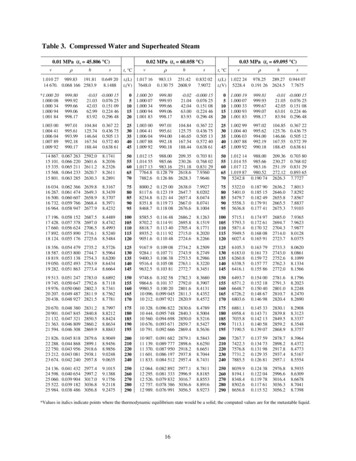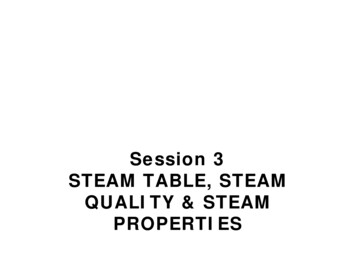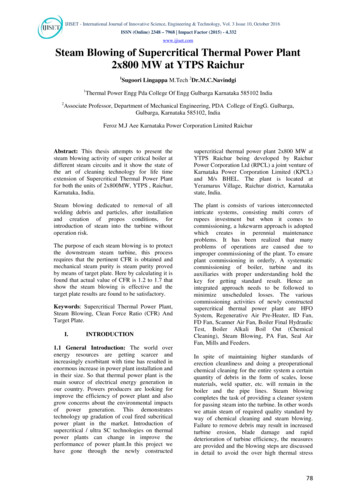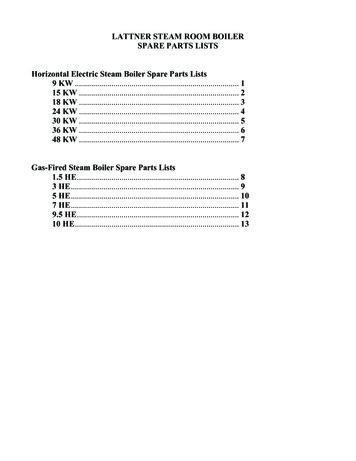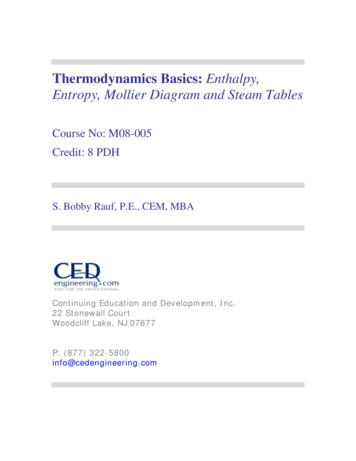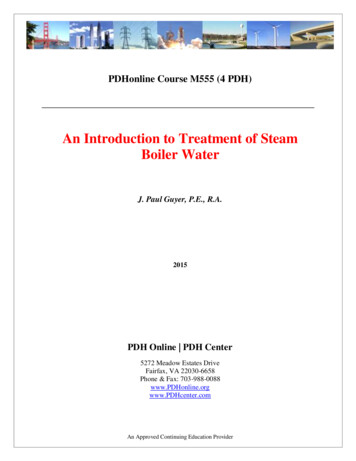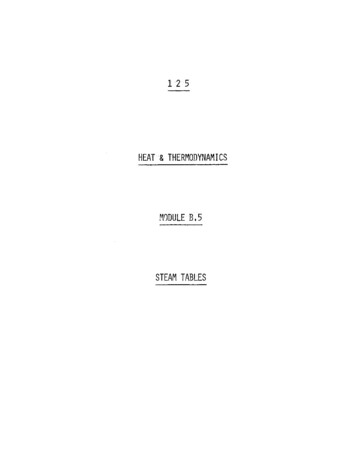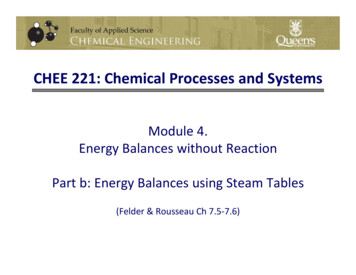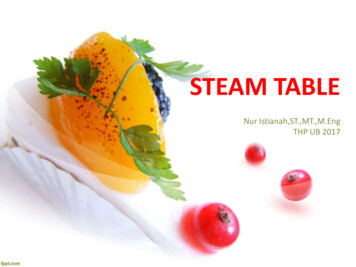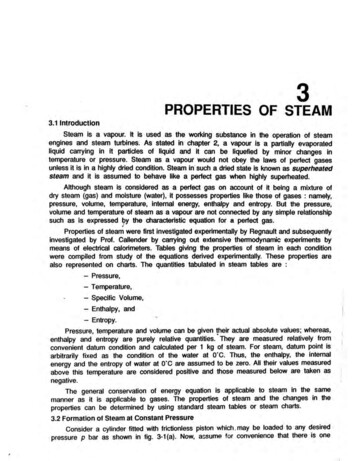
Transcription
3PROPERTIES OF STEAM3.1 IntroductionSteam is a vapour. It is used as the working substance in the operation of steamengines and steam turbines. As stated in chapter 2, a vapour is a partially evaporatedliquid carrying in it particles of liquid and it can be liquefied by minor changes intemperature or pressure. Steam as a vapour would not obey the laws of perfect gasesunless it is in a highly dried condition. Steam in such a dried state is known as superheatedsteam and it is assumed to behave like a perfect gas when highly superheated.Although steam is considered as a perfect gas on account of It being a mixture ofdry steam (gas) and moisture (water), it possesses properties like those of gases : namely,pressure, volume, temperature, internal energy, enthalpy and entropy. But the pressure,volume and temperature of steam as a vapour are not connected by any simple relationshipsuch as is expressed by the characteristic equation for a perfect gas.tProperties of steam were first investigated experimentally by Regnault and subsequentlyinvestigated by Prof. Callender by carrying out extensive thermodynamic experiments bymeans of electrical calorimeters. Tables giving the properties of steam in each conditionwere compiled from study of the equations derived experimentally. These properties arealso represented on charts. The quantities tabulated in steam tables are :- Pressure,- Temperature,- Specific Volume,- Enthalpy, and- Entropy.Pressure, temperature and volume can be given their actual absolute values; whereas,enthalpy and entropy are purely relative quantities. They are measured relatively fromconvenient datum condition and calculated per 1 kg of steam. For steam, datum point isarbitrarily fixed as the condition of the water at O'C. Thus, the enthalpy, the internalenergy and the entropy of water at O'C are assumed to be zero. All their values measuredabove this temperature are considered positive and those measured below are taken asnegative.The general conservation of energy equation is applicable to steam in the samemanner as it is applicable to gases. The properties of steam and the changes in theproperties can be determined by using standard steam tables or steam charts.3.2 Formation of Steam at Constant PressureConsider a cylinder fitted with frictionless piston which, may be loaded to any desiredpressure p bar as shown in fig. 3-1 (a). Now, assume for convenience that there is one
PROPERTIES OF STEAM55kilogram of water initially at temperature O'C in the cylinder under the piston and thepiston exerts a constant pressure p bar. Let the area of the piston be one square metreand the volume of one kilogram of water be vw m3, the length of the cylinder occupiedby water will be vw m. Now, let heat be supplied to the water in the cylinder. Thetemperature of water will rise when sensible enthalpy be supplied. The rise in temperaturewill continue until the boiling point is reached, where it will remain constant. The temperatureat which water boils depends upon the pressure on it. For any given pressure, there isone definite boiling point. The boiling point is called the saturation temperature (ts) or thetemperature of steam formation. Water boils at 99-63‘C when the pressure on it is 1 bar,and at 18409'C when the pressure on it is 11 bar (these values are taken from steamtables). rJ C L ,’Snnn,1 'vpIIT! j l \ i ff1%'supV 'M tk\ m1» « irhi ni - P " r.AU wa*era*. 0*CH a lf w a te r% half steamA ll steamat t sat t s(aip j cT7M 'I'* * *(b)(c)(d)A l l steamat tsup(e)Fig. 3-1. Formation of steam at constant pressure.The water will expand slightly during the rise of temperature. The increase in volumeof water causes the piston to move up slightly as shown in the fig. 3-1 (b), thus, workis done in moving the piston against this pressure p. This work, however, is only a smallportion of the heat added to water during the rise in temperature and may be neglectedin general. Figure 3-1 (a) represents the condition before the first stage commences andfig. 3-1 (b) represents the condition at the end of the first stage. It will be noted that thepiston is at slightly higher level at the end of operation.The next stage, as shown in fig. 3-1 (c), is the actual production of steam. If theheating of this one kilogram of water is continued after the boiling point is reached, itwill be noticed that there is no further increase in temperature, as the pressure ismaintained constant but steam begins to form and piston commences to ascend (rise) inthe cylinder, rising higher and higher as more and more steam is formed. The heatabsorbed is now utilised in converting water into steam and is known as evaporationenthalpy or latent heat. As long as there is some water left unevaporated in the cylinder,the steam formed will not be pure (dry) steam, but will have some water mixed with it.In fig. 3-1 (c), part of water is evaporated and the cylinder has in it, rAixture of water andsteam (about half steam and half water). A mixture of steam and water is called wetsteam.If the heating of this wet steam is further continued and as soon as last particle ofwater in suspension in wet steam disappears (evaporates), the steam produced is knownas dry saturated steam.
ELEMENTS OF HEAT ENGINES Vol.lFigure 3-1 (d) shows that the process of formation of steam is completed. The wateris entirely evaporated and the volume of steam below the piston is vs m3 (vs is thevolume of one kilogram of dry saturated steam at a given pressure p). The piston willrise to accommodate this increased volume, and will occupy length vs m of the cylinder.The work done on the piston during the change of volume of the steam from vw to vs10Sp (v s v w) ---------- ------103kJwhere p is the pressure in bar. (3.1a)If p is in kPa, then the above expression is written asWork done p(vs - vw) kJ. (3.1b)Finally, if further, heat is added to one kilogram of dry steam in the cylinder at theconstant pressure, the temperature of steam will rise and there will be further increasein volume of steam as shown in fig. 3-1 (e). The steam produced is known as superheatedsteam.Figure 3-2 shows graphically that whathappens when heat is added to one kilogramof water initially at 0’C. The heat added isplotted along the horizontal axis in kJ unitswhile the corresponding temperatures areplotted along the vertical axis in centigradeunits.During the first stage of heating, thetemperature of water will begin to rise untilthe water boils at a temperature known assaturation temperature which depends uponthe pressure in the cylinder. After the boilingtemperature is reached, steam begins to beformed during which time the temperatureremains constant. Until the point is reachedHeat added— » kjat which all water is converted into steam,Fig. 3-2. Formation of steam at constant pressure,the contents of mixture will be steam andwater known as wet steam. When all thewater including those particles of water held in suspension will be evaporated, the steamis said to be dry and is known as dry saturated steam. As heating continues further,the temperature of steam begins to rise again and steam is now known as superheatedsteam and behaves more or less as a perfect gas.3.2.1 Enthalpy : For reasons too long to explain here, the term heat content is notrecommended for use in thermodynamics. The terms formerly known as “heat of water"(sensible heat), “heat of evaporation” (latent heat) and “total heat of steam" are nowknown as the “enthalpy of (saturated) water”, “enthalpy of evaporation” and “enthalpy ofsaturated steam” respectively. Similarly, the term total heat of superheated st am is nowknown as “enthalpy of superheated steam”. Enthalpy of evaporation is the differencebetween enthalpy of dry saturated steam and enthalpy of (saturated) water, i.e,Enthalpy of evaporation Enthalpy of dry saturated steam - Enthalpy of boiling water3.2.2 Enthalpy of Water : The amount of heat absorbed by one kilogram of waterin being heated from the freezing point (0*C) to the boiling point ts, is known as the 'enthalpy of the saturated water (sensible heat of water) and is denoted by the symbol Ij
PROPERTIES OF STEAM57h. It is customary to reckon the enthalpy of water from O'C at which temperature theenthalpy of water is said to be zero. To raise the temperature of one kilogram of waterfrom O'C to 100"C requires 4-187 x 100 418-7 kJ; hence this number is the enthalpyof one kg of water at 100*C. If the temperature of water to begin with is say 20*Cinstead of O'C, then number of heat units required to raise 1 kg of water at 20*C towater at 100*C is equal to 4-187 (100 - 20) 334-96 kJ, where 4-187 kJ/kg K is thespecific heat water.If the specific heat of water were 4-187 kJ/kg K at all temperatures, then the enthalpyof water would be 4-187 (ts - 0) kJ/kg. For engineering purpose, it is of sufficient accuracyto assume the value of specific heat of water (/c) to be 4-187 kJ/kg K at low pressuresin which case,Enthalpy of (saturated) water, h at any temperature ts above 0’C ish 4-187 x (ts - 0) kJ/kg. (3.2)The error in results calculated by this formula becomes larger as the temperaturerises. The value of enthalpy of saturated water, h given in column 4 of the steam tables(given at the end of this book) should be used in preference to the results calculatedfrom the above formula.3.2.3 Enthalpy of Evaporation : The enthalpy of evaporation tor latent heat) isdefined as the amount of heat required to convert one kilogram of water at a giventemperature ts and pressure p into steam at the same temperature and pressure. Thevalue of enthalpy of evaporation varies with the pressure. It is usually expressed by thesymbol L and its value at 1 bar is 2,258 kJ per kg. The value of enthalpy of evaporation,L of 1 kg of dry saturated steam can be directly obtained from the steam tables.The value of enthalpy of evaporation of dry saturated steam is given in column 5of the steam tables.3.2.4 Enthalpy of Dry Saturated Steam : It is the sum of enthalpy of saturatedwater and enthalpy of evaporation and is defined as the quantity of heat required to raisethe temperature of one kilogram of water from freezing point to the temperature ofevaporation ts (corresponding to given pressure p) and then convert it into dry saturatedsteam at that temperature and pressure. It is denoted by the symbol Hs. The enthalpyof one kg of dry saturated steam, Hs enthalpy of (saturated) water enthalpy ofevaporation,. (3.3)i.e., Hs - h L kJ/kgThe value of enthalpy (total heat), H of 1 kg of dry saturated steam can be directlyobtained from the steam tables corresponding to given value of pressure or temperature.The value of enthalpy of dry saturated steam is given in column 6 of the steam tables.Enthalpy of evaporation is the enthalpy difference between diy saturated steam andsaturated water.3.2.5Wet Steam : The steam in the steam space of a boiler generally containswater mixed with it in the form of a mist (fine water particles). Such a steam is termedas wet steam. The quality of steam as regards its dryness is termed as dryness fraction.Dryness fraction is usually expressed by the symbol x or q. Dryness fraction is oftenspoken as the quality of wet steam.If ms mass of dry steam contained in the steam considered, andm mass of water in suspension in the steam considered.
58ELEMENTS OF HEAT ENGINES Vol.lThen, dryness fraction, x — — —ms mThus, if drynes -fraction of wet steam, x 0-8, then one kg of wet steam contains0-2 kg of moisture (water) in suspension and 0-8 kg of dry steam.When the steam produced is not dry steam, but a mixture of steam and water asis often the case, the enthalpy of one kilogram of mixture of water and steam (wet steam)is less than enthalpy of the same quantity of pure or dry steam. To generate steam ofdryness fraction 0 -8 , takes only 0-8 of the enthalpy of evaporation necessary for theformation of dry steam at the same temperature. Hence, enthalpy of evaporation of onekg of wet steam is the value of the enthalpy of evaporation given in steam tables fordry steam, at the required pressure, multiplied by its dryness fraction x.i.e. Enthalpy of evaporation of 1 kg of wet steam xL kJ/kg. (3.5)Enthalpy of wet steam is the amount of heat required to raise the temperature ofone kilogramof water from freezing point (0*C) to the boiling point ts (corresponding togiven pressure, p) and then to convert the boiling water into wet steam,i.e. Enthalpy of one kg of wet steam - enthalpy of saturated water enthalpy ofevaporation,i.e. Hwet m h xL kJ/kg. (3.6)3.2.6 Superheated Steam : If the steam remains in intimate contact with waterduring its formation, interchange of molecules between the water and steam will result.This interchange of molecules will continue as long as there is any water in the cylinderof fig. 3-1 (d). This will not allow the steam to become dry.If the water is entirely evaporated and further heat is then supplied, the first effecton the steam is to make it dry if it is not already dry. The temperature of steam willthen begin to increase with a corresponding increase in volume. Steam in this condition,heated out of contact with water, is said to be superheated. Superheating is assumed totake place at constant pressure. The amount of superheating is measured by the rise intemperature of the steam above its saturation temperature (ts). Greater the amount ofsuperheating, the more will the steam acquire the properties of a perfect gas.In practice, steam is superheated after it has left the boiler by passing it through anest of tubes known as superheater. The superheater is heated externally by the furnacegases of the boiler. The additional heat supplied to steam during the process of superheatingis known as the heat of superheat.Heat absorbedkg of dry steam during superheating kp(tsup - ts) kJ/kg.(3.7)where tsup temperature of superheated steam,* ts saturation temperature at the given pressure, andkp - mean specific heat of superheated steam at constant pressure.The temperature rise (tsup - ts) is termed as dgree of superheat. It means thenumber of degrees of temperature by which steam at a given pressure is raised abovethe saturation temperature corresponding to that pressure. The condition of superheatedsteam is given either by its degree of superheat or by its temperature. The value ofspecific heat of superheated steam (kp) varies with the pressure and decree of superheating.It increases with the increase of pressure and decreases with the incr se of degree ofsuperheating. The value of specific heat at constant pressure of superheated steam (kp)varies from 2 to 2-5 kJ/kg K.
PROPERTIES OP STEAM59The enthalpy (or total heat) of one kg of superheated steam may be defined as thenumber of heat units required to convert one kg of water at freezing temperature (O'C)into superheated steam at a given pressure and temperature, assuing that the heat isadded at constant pressure, which is the case in practice. The enthalpy of 1 kg ofsuperheated steam is, therefore, the sum of enthalpy of water, the enthalpy of evaporation,and the heat of superheat. It is denoted by symbol Hsup. Hence, enthalpy of one kg ofsuperheated steam,H up — h L fcp( jup ” (s) B p(fsupfs) kJ/kg. (3.8)3.2.7 Specific Volume of Steam : The volume of one kilogram of dry saturatedsteam at all pressures is given in column 3 of the steam tables. The value in cubicmetre per kg of dry saturated steam (m3/kg) is known as the specific volume of drysaturated steam and its symbol is v*Density of dry steam is the mass of one cubic metre of steam (kg/m ) and is thereciprocal of specific volume and, therefore, is equivalent to 1/vs kg per cubic metre.If the steam is wet, having a dryness fraction of x, one kg of wet steam will consistof x kg of dry (pure) steam and (1 - x) kg of water held in suspension.Specific volume of wet steam, having a dryness fraction of x volume of dry steam volume of water particles xvs (1 - x)vwwhere, vs and vw denote the specific volume of steam and water respectively.As the volume of water at low pressure is very small compared with the steam, theterm (1 - x)vw will become still smaller and can be neglected.Hence, the specific volume of wet steam, neglecting volume of water particles xvs m3/kg, and density of wet steam 1/xvs kg/m .For some problems of thermodynamics, it is sufficiently accurate that, at a givenpressure, the volume of superheated steam is proportional to its absolute temperature.This assumption is made on the ground that superheated steam behaves like a perfectgas. The approximate specific volume of superheated steam may be calculated from theexpression,Vsup Vs XTsupI 3,.m /kg— (3-9)where Tsup is the absolute temperature of superheated steam, Ts is the absolutesaturation temperature of steam and vs is the specific volume of dry saturated steam.3.3 Steam TablesReference is now made to the steam tables which give the properties of 1 kg ofdry saturated steam. The information given in steam tables (given at the end of thisbook) has been obtained by performing experiments on dry saturated steam at variouspressures and temperatures. In the steam tables, the initial temperature of water is takenas O’C.Absolute pressures given in column 1 of the steam tables are in bar. Before thesteam tables can be used, it is necessary to convert boiler gauge pressure (shown bythe steam pressure gauge fitted on the boiler) to absolute pressure. This is obtained byadding atmospheric (barometric) pressure to boiler gauge pressure. See solved problemno.5. The information contained in steam tables is as under :
60ELEMENTS OF HEAT ENGINES Vol.lAbsolute pressure of steam. p barSaturation temperature of steam (temperature of formation of steam)Specific volume of dry saturated steam. fe*C. vs m3/kgEnthalpy of saturated water (reckoned above 0’C). h kJ/kgEnthalpy of evaporation of dry steam. L kJ/kgEnthalpy of dry saturated steam (reckoned above 0’C). Hs kJ/kgEntropy of saturated water. 4 w kJ/kg KEntropy of dry saturated steam. 0 s kJ/kg KIt is important to note that the data given in steam tables is for dry saturated steamonly and therefore, the effect of dryness fraction (x) must be taken into account in themanner already explained. The enthalpy of wet steam and superheated steam can becalculated by using eqns. (3.6) and (3.8).The properties of 1 kg of dry saturated steam at various absolutepressures aregiven in steam tables, at the end of this book.Note : In this text, the pressures stated in bar, kPa and MPa will indicate absolute pressures. Gauge pressurewill be indicated as gauge pressure or pressure gauge reading.Problem-1 : Determine the dryness fraction of steam if 0-8with 45 kg of dry steam.of water is in suspensionMass of wet steam mass of dry steam in 1 [certain mass of wet steamjf mass of water in suspension[in the same mass of wet steam 45 0 8 45-8 kg.Thus, in 45-8 kg of wet steam, the dry steam is 45 kg.The dryness fraction of wet steam is the ratio of the mass ofactual dry steam tothe mass of wet steam containing it.Dryness fraction, x 45/45-8 0-982i.e. Steam is 98-2 per cent dry or 1-8 per cent wet.Problem-2 : How much heat is needed to convert 1 kg of feed water at 20'C into drysaturated steam at 10 bar (1 MPa) ? Take specific heat of water as 4-187 kJ/kg K.From steam tables, at 10 bar, enthalpy of saturated water, h 762-81 kJ/kg andenthalpy of evaporation, L - 2,015-3 kJ/kg.Enthalpy of dry saturated steam at 10 bar (above 0’C), Hs h L 762 81 2,015 3 2,778-11 kJ/kg.Enthalpy of 1 kg of feed water at 20’C above 0’C k (ti - 0) 4-187 (20 - 0) 8374 kJ/kg.Heat supplied to convert 1 kg of feed water at 20’C into dry saturated steam at10 bar enthalpy of dry saturated steam - enthalpy of feed water- 2,778 11 - 83 74 2,694-37 kJ/kg.Problem-3 : How much heat is needed to convert 5 kg of water at 40'C into 90 percent dry (or 10 per cent wet) steam at 5 bar (500 kPa) ? Take specific heat of wateras 4 187 kJ/kg K.
PROPERTIES OF STEAM61From steam tables, at 5 bar, h 640-23 KJ/kg and L - 2,108 5 kJ/kg.Enthalpy of 1 Kg of wet steam at 5 bar and 0-9 dry above O’C,H*e\ h xL 640 23 0-9 x 2,108-5 * 2,537-88 KJ/Kg.Enthalpy of 1 Kg of feed water at 40’C above O’C k(U - 0) 4-187 (40 - 0) 167-48 KJ/Kg.Heat needed to convert 1 Kg of feed water at 40’C into wet steam at 5 bar and0-9 dry Enthalpy of wet steam - Enthalpy of feed water 2,537 88 - 167-48 2,370 4 kJ/kg.Heat supplied to convert 5 kg of water at 40’C into steam at 5 bar and 0-9 dry- 5 x 2,370 4 11,852 kJ.Problem-4 : How much heat is needed to convert 4 kg of water at 20’C into steam at8 bar(800 kPa) and 200'C. Take kp of superheated steam as 21 kJ/kg K and specificheat of water as 4187 kJ/kg K.From steam tables, at 8 bar, ts 170-43'C, h m 721-11 kJ/kg and L 2,048 kJ/kg.Since the temperature (200’C) of given steam is more than saturation temperature, ts(170-43’C), the steam is superheated.Degree of Superheat feup - fe 200 - 170-43 29-57'C.Enthalpy of 1 kg of superheated steam (above O'C),Hslip h L kp (fsup - ts) 721-11 2,048 2-1 (200170-43) 2,831-21 kJ/kgEnthalpy of 1 kg of water above O'C k (ti - 0) 4-187 (20 - 0) 83-74 kJ/kg.Heat needed to convert 1 kg of waterat 20'C into superheated steam at 8 bar and200'C Enthalpy of superheated steam - Enthalpy of water 2,831 21 - 83-74 2,747-47 kJ/kgHeat needed to convert 4 kg of water into steam 4 x 2,747-47 10,990 kJ.Problem-5 : A boiler is supplied with feed water at a temperature of 44'C and convertedinto steam at a gauge pressure of 4-493 bar and a temperature of 188’C. If 900 kg ofsteam is generated by the boiler in one hour, find the quantity of heat supplied perminute to feed water to produce steam assuming barometric pressure of 750 mm of Hgand kp of superheated steam as 2 1 kJ/kg K.Now, 760 mm of Hg 1-01325 bar.1-01325 x 7 50750 mm of Hg ------- ------------ 1-007 bar (barometric pressure)Absolute pressure of steam Boiler gauge pressure Barometric pressure 4-493 1-007 5-5 bar.Referring to steam tables, at 5-5 barh 655-93 kJ/kg, L 2,097 kJ/kg and ts 155-48'C. Since the temperature of given steam (188'C) is morethan the saturationtemperature (155-48‘C), the steam produced is superheated.Enthalpy of 1 kg of feed water at 44’C above O’C k (ft — 0) 4.187 (44 - 0) 184 23 kJ/kg.
62ELEMENTS OF HEAT ENGINES Vol.lEnthalpy of (saturated) water - h - k(U - 0) 65593 - 184-23 471-7 kJ/kg.Heat supplied/kg [h - k (U - 0) L Ap(feup - ts)] 471-7 2,097 2-1 (188 - 15548) 2,636-99 kJ/kgHeat supplied per min. — x 2,636-99 39,554 85 kJ/mln.ouProblem-6 : Find the volume of one kilogram of steam at a pressure of 15 bar (15MPa) in each of the following cases :(i) when steam is dry saturated,(ii) when steam is wet having dryness fraction of 09, and(iii) when steam is superheated, the degree of superheat being 40'C.At 15 bar, vs 0-13177 m3/kg and ts 198-32'C (from steam tables).(i) When steam is dry saturated:Specific volume {vs) of dry saturated steam at 15 bar is 0-13177 m3/kg.(ii) When steam is wet, dryness fraction 0 9 :Specific volume of wet steam of dryness fraction x, neglecting the volume of water xvs m3/kg.% Volume of wet steam at a pressure of 15 bar and 0-9 dry xvs 0-9 x 0-13177 * 01186 m3/kg(iii) When steam is superheated by 40'C :Absolute temperature of saturated steam, Ts - 198-32 273 471-32 KAbsolute temperature of superheated steam, Tsup 198-32 40 273 511-32 KThe specific volume of superheated steam is given by eqn. (3-9),vsup vs x 0-13177 x i 0-1426 m3/kg.Problem-7 : A closed vessel contains 12 m3 of dry saturated steam at 14 bar (14MPa). What is the temperature and mass of this steam ?From steam tables, saturation temperature corresponding to 14 bar 195-7*C.Specific volume (vs) at 14 bar 0-14084 m3/kg (from steam tables)., *Volume of steam1-2.-. Mass of steam — -tt .;------- — —— — . . . . . . 8 52 kg.Specific volume of steam (vS)0-14084Problem -8 : Determine the condition of steam in each of the following cases :(i) at a pressure of 10 bar and temperature 200‘C,(ii) at a pressure of 8 bar and volume 022 m /kg, and(iii) at a pressure of 12 bar, if 2,688 kJ/kg are required to produce it from water at 0 ‘C.(i) Saturation temperature (ts) corresponding to pressure of 10 bar from steam tables is179-91 *C. Since the temperature of given steam is 200'C, the steam is superheated. Itsdegree of superheat, Isup - ts - 200 -179-91 * 20-09’C.
PROPERTIES OF STEAMoo(ii) Specific volume of dry saturated steam (vs) at 8 bar is 0-2404 m3/kg. Since the volumeof given steam (0-22 m3) is less than the specific volume of dry saturated steam, it isobvious that the steam with a volume of 0-22 m3/kg is wet.Dryness fraction, x 0-22/0-2404 0-915 i.e. 91-5% dry.(iii) Enthalpy of dry saturated steam (H) at 12 bar from steam tables is 2,784-8 kJ/kg. Sincethe enthalpy of given steam(2,688 k J/kg) is less than the enthalpy of dry saturated steam,we conclude that the given steam is wet.At 12 bar, h 798-65 kJ/kg, L 1,986-2 kJ/kg (from steam tables).Using eqn. (3-6) for determining quality of steam, Hwet h xLi.e. 2,688 798 65 x 1,986-2Dryness fraction of steam, x 0-9513 i.e. 95-13% dry1,9 8 6 *2Problem-9 : A boiler is supplying steam at a pressure of 9 bar and 90 percent dry.Find : (i) the mass of 5 m of this steam, and (ii) the enthalpy per m3 of this steamabove 0'C.(i) From steam tables, at 9 bar,h 742-83 kJ/kg, L 2,031-1 kJ/kg,andvs 0-215 m3/kg.311Mass of one m of wet steam — — — , 5-168 kgxvs 0-9 x 0-215Mass of 5 m3 of wet steam 5 x 5-168 25-84 kg(ii) Enthalpy of 1 kg of wet steam at a pressure of 9 bar and dryness fraction 0-9,Wwet h xL a 742 83 0-9 x 2,031-1 2,570-83 kJ/kg.-. Enthalpy of one m3 of wet steam mass of steam x (h xL) 5-168 x 2,570-83 13,286 kJ.Problem-10 : Determine from steam tables the following :(i) Enthalpy and volume of 1 kg of steam at 12 1 bar and dryness fraction 09, and(ii) Enthalpy and volume of 1 kg of steam at 12 1 bar and 225’C.Take the specific heat at constant pressure for superheated steam as 2-1 kJ/kg K.By using steam tables and interpolating to find the values for a pressure of 12-1bar, a table is constructed as shown below 651986-22784-80-16333from steam tables12 2188 74801 981983-42785-40-16077from steam tables020753-332806000256for 0-2 bar010-381 67140-30-00128for 0-1 bar12 1188 37800-321984 827851016205by interpolating(i) Enthalpy of 1 kg of steam at 12-1 bar and 0-9 dry,Hwet h xL 800 32 0 9 x 1,9848 2,463 52 kJ/kg.Volume of 1 kg of steam at 12-1 bar and 0-9 dry
64ELEMENTS OF HEAT ENGINES Vol.l x x v8 « 0-9 xO 16205 « 014585 m3/kg(ii) Enthalpy of 1 kg of steam at 12-1 bar and 225*C,Hsup H kp{tsup - ts) - 2,785-1 21(225 - 188-37) 2,862-02 kJ/kgUsing eqn. (3-9), volume of 1 kg of superheated steam at 12-1 bar and 225'C,Vsup vs x 0-16205 0-1751 m 3/kg.XProblem-11 : One kg of steam initially at 8 bar (800 kPa) and 0 7 dry, receives 410 kJheat at constant pressure. Determine the enthalpy, condition, and density of steam at theend of constant pressure heat supply.From steam tables, at 8 bar, h 721-11 kJ/kg, L 2,048 kJ/kg, vs 0-2404 m3/kg.Enthalpy initially, H i - /?i X1L1 721-11 0-7 x 2,048 2,154-71 kJ/kgEnthalpy at the end of constant pressure process, H2 2,154-71 410 2,564-71 kJ/kgLet the final condition of steam be xz. Then, H2 hz X2L2From which, xz — 7 — Lz2,048 0-9 dry (final condition of steam)113Density of steam ----- . 4 62 kg/m .xzvs 0-9 x 0-2404Problem-12 : Two boilers A and B, are delivering steam in equal proportion to a commonmains steam pipe, both at a pressure of 14 bar. Boiler A has a superheater and boilerB is without a superheater. The temperature of steam supplied by the boiler A is 300"C.The temperature of the resulting mixture of steam in the steam mains is 235"C. Assumingkp for the superheated steam as 2-1 kJ/kg K, estimate the quality of steam supplied bythe boiler without the superheater, i.e., boiler B.From steam tables, at 14 bar, L 1,959-7 kJ/kg and ts 195-07’C.The wet steam from boiler B gains heat from the superheated steam produced byboiler A. As * result of which it (wet steam) becomes superheated. During theprocessof its mixing with superheated steam, first its moisture content isevaporated and then itis superheated. Let the dryness fraction of wet steam generated by boiler B be x.Then, moisture in 1 kg of wet steam (1 - x) kg. Heat required to evaporate thismoisture and to make it dry (1 — x)L kJ/kg.Heat required to superheat this dry steam kp(tsup2 - ts) kJ/kg.Heat gained by the wet steam of boiler B (1 - x)L kp(tSup2 - fe) kJ/kg.Heat lost bythe superheated steamof boiler A Heat gainedby wet steam of boilerB Heat lost by superheated steamfcp(feupi- feup2)of boiler Ai.e. (1 — x) L kp(tsup2 t ) s kp(tsupy— feup2)i.e. (1 - x) 1,9597 21(235 - 195 07) 2-1(300 - 235)1 007-05x 0-9732 i.e. 97-32% dry (quality of steam supplied byboilerB)Problem-13 : Aboiler generates 1,400kg of steam per hour at a pressure of 18bar(18 MPa) and 095 dry. The steam after leaving the boiler stop valve, passes through1 superheater where its temperature is raised to 305"C. If the feed water supplied to the
PROPERTIES OF STEAM65boiler is at 40'C, calculate : (a) the heat supplied to feed water per hour to producewet steam, and (b) the percentage of the heat absorbed in the boiler and in thesuperheater. Take kp of superheated steam as 2 3 kJ/kg K and specific heat of wateras 4 187 kJ/kg K.From steam tables, tit 18 bar, H 884-79 kJ/kg, L - 1,912-4 kJ/kg and ts 207-15’C.(a) Heat supplied to feed water to produce wet steam in the boiler per hour Ws [h - k(t, - 0) xL] 1,400 [884 97 - (4-187 x 40) 0 95 x1,912-4] 35,47,700 kJ/hr
L of 1 kg of dry saturated steam can be directly obtained from the steam tables. The value of enthalpy of evaporation of dry saturated steam is given in column 5 of the steam tables. 3.2.4 Enthalpy of Dry Saturated Steam : It is the sum of enthalpy of saturated water and enthalpy of evaporati

